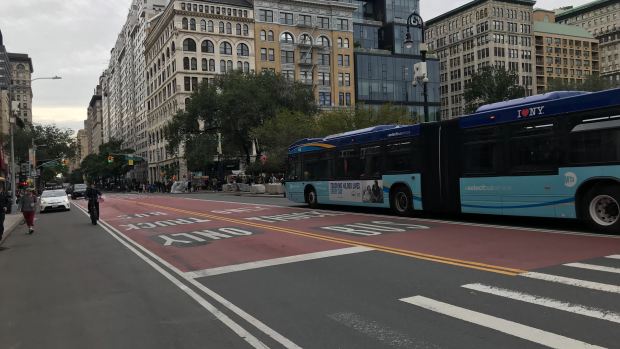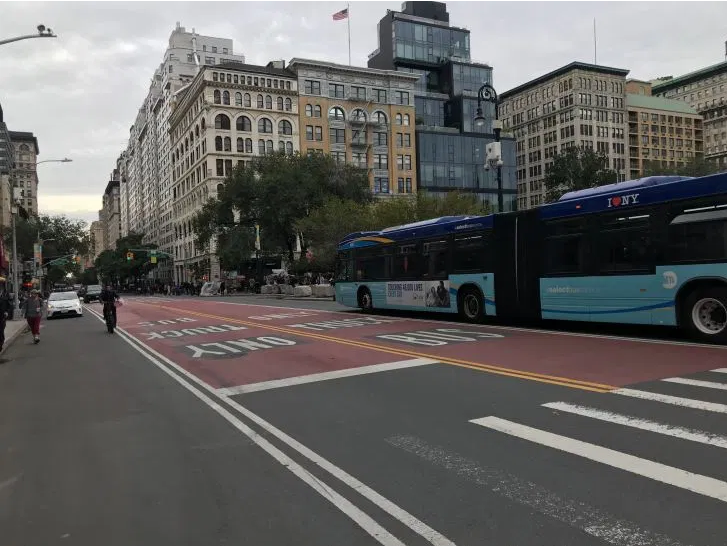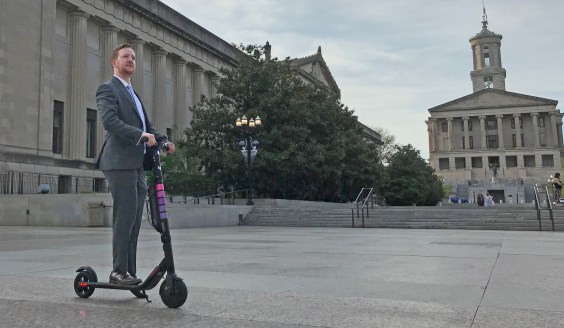
The 14th Street Busway is working exactly as expected — unless your expectations were formed by the New York Times and other pro-car media outlets.
On Tuesday, the fourth full day since the city mostly banned cars between Third and Ninth avenues, the M14 bus — once the city’s slowest — continues to move with impressive speeds. And 14th Street itself is no longer full of honking, gridlocked traffic. People are saying they now like to walk on the crosstown roadway. Posters on Twitter are reveling in the quiet. Activists are demanding the same treatment on other roadways where buses with 100 people in them are stuck behind single-occupancy cars.
In short, it’s a miracle.
But this isn’t how it was supposed to be. In fact, if you read the New York Times last week, you would think a car-free busway would be the end of business as we know it.
Before the busway was implemented, the owner of Namaste, a small bookstore between Fifth and Sixth avenues, told the Times that he’d lose customers due to a loss of parking. The manager of Joe’s Pizza said more or less the same thing.
It’s “horrible for me and my business because it [will] stop customers from coming,” Salvatore Vitale told the paper of record, which did not bother to ask customers where they came from or how they got there. On Tuesday at 2 p.m., there were seven customers inside Joe’s, all enjoying excellent slices. None drove there or was driven there.
The same was true on Monday, where we spotted Mike Richardson, sitting in a window seat polishing off a slice. He said he walks to Joe’s two to three times a week from his job on Park Avenue and 22nd Street.
“The busway doesn’t affect me,” Richardson shrugged when asked what he thought of the new street design, explaining that he walks, eats his pizza and walks back. “I’m just here for a block.”
Streetsblog did find someone at Joe’s who had been delivered there by a cab — whose pickups and drop-offs are not restricted by the busway rules.
Meanwhile, at Crossroads Wines and Liquors, there was plenty of foot traffic coming through the door.
“I felt like stopping in, I was seeing if maybe I would get a gift for someone,” Neyda Martinez said as she exited Namaste before she went to her job as an associate professor at The New School. Martinez is not a bus rider, but she raved about the new 14th Street as feeling much safer for pedestrians. Logically speaking, she added, “It doesn’t make sense to have all these great new buses if they move at a snail’s pace.”
It certainly didn’t make sense to the writers and editors at the Times, which had earlier quoted Crossroads manager Ray Raddy saying that the busway would kill his business because customers would realize they couldn’t drive to the store and would say, “I’m not comfortable coming here, I’ll go somewhere else.”
The comment was so objectively absurd — do people really drive to a tiny neighborhood liquor store on a perpetually congested thoroughfare? Did the reporter even ask that question?— that the Times ended up cutting it from the end-of-day story on the busway’s success (though Reddy’s remark lives on thanks to the Wayback Machine).
A customer named Stephen provided a more accurate picture of Raddy’s customer base. He said he stopped to browse at the store while his phone was being repaired nearby, a scenario that is far more likely to happen by foot than by car. Stephen added another helpful factor for businesses: car traffic on 14th Street was so dramatically reduced that he felt safe to cross the road to shop.
“I noticed I could cross … and didn’t have to look out for cars,” he said, adding that the street is now “much friendlier.”
He hopes the car ban remains in effect after the 18-month test period is completed.
He also pushed back on opponents of the busway, who claimed in their lawsuit that the car ban would “cause horrific traffic jams on 12th Street, 13th Street, 15th Street, 16th Street, 17th Street, 18th Street, … 19th Street, and 20th Street.”
“I’ve seen nothing out of the ordinary,” he said.
Business owners aren’t the only beneficiaries of the increasingly pleasant byway/busway.
Members of the West 13th Street Alliance — not to be confused with busway litigants such as the Upper West 13th Street Block Association and the West 13th Street 100 Block Association — tweeted their excitement at the quiet roads and calm streets reclaimed from the automobile.
What is happening on #west13thstreet ? No cars. Bizarre. Video taken at 2:10pm today. pic.twitter.com/O7UtHmNIA7
— The West 13th Street Alliance (@W13thStAlliance) October 7, 2019
Fear of car restrictions is, of course, nothing new, even in a city with extremely low car ownership rates. And the charge that transit improvements will destroy local commerce is the most-common refrain, as it allows the pro-car contingent to hide behind the specter of shuttered businesses, the bane of the local politician. Some residents of Ridgewood, Queens, for example, sued to stop a bus lane on Fresh Pond Road because it required the removal of some on-street parking along a commercial strip. And a flower shop owner in Sunnyside recently came out against a Citi Bike expansion that would also reclaim some of the curb. His reasoning? People on bikes or on foot don’t buy flowers.
“This will impact my business in a bad way,” Giorgie Calle, owner of Flowers by Giorgie, told the Queens Eagle. “People who want to ride bikes should go to the parks. There are buses and trains to commute to stores.”
Such comments — and the shamelessly pro-car coverage in the Times — simply don’t ring true to anyone who understands the city.
“Especially in Manhattan, where very few people are driving, foot traffic should be the most important metric for anyone,” said Joe Cutrufo, the spokesman for Transportation Alternatives, which strongly backs the busway. “And, if anything, the Busway improves foot traffic because it brings more bus riders.”
Cutrufo added that so few neighborhood residents drive in Manhattan, and congestion from out-of-town commuters and booming construction is so bad, that any business that caters to drivers is setting itself up to fail.
“It’s strange to imagine that your customers are driving to your store when in the immediate area, practically nobody drives,” Cutrufo said. “In Manhattan, less than a quarter of households own a car, and if you wanted to be dropped off somewhere on 14th Street that can still happen. The notion that we shouldn’t allow buses to go faster on a street is ridiculous, especially in Manhattan.”
And he wasn’t the only one calling BS on the fantasy of the Business Busting Busway. Julia Delaney, who said she finds herself in the area between 14th Street and Houston Street often and is a semi-frequent Joe’s Pizza customer, scoffed when asked if Vitale had a legitimate concern with the Busway.
“The street looks better, it’s nice,” Delaney said. “It’s ridiculous, I don’t know any New Yorker who would take a cab just to get a slice of pizza.”






